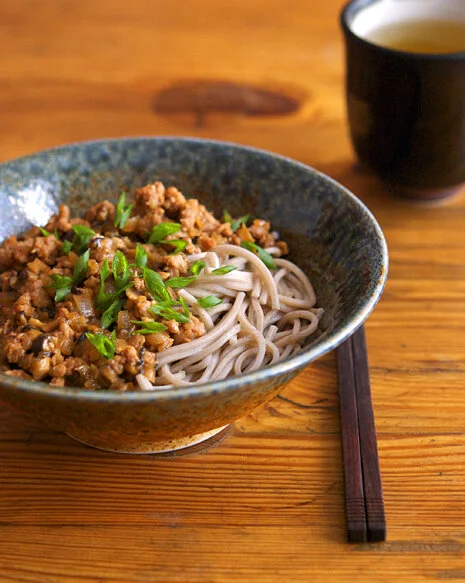This dish of minced pork ladled over soba is comfort food at its best.
Read MoreI love owning a bamboo steamer, if for no other reason that to display around the kitchen. It's not only a conversation starter whenever new guests visit but also a handy tool for food photography. (Gotta play up the Asian theme sometimes.) Plus, a set of basket and lid usually costs less than $10 in Chinatown.
Of course, there are times when bamboo steamers are useful for actual cooking. Aside from har gow, shumai is possibly the most requested dim sum standard in my family, with the reliable crinkly yellow wonton wrappers snugly encasing the pork-dominant filling. I haven't tackled har gow at home yet, possibly because even 95% of all restaurants I visit fail at the texture of the translucent wrapper. But siu mai I can do.
Read MoreUntil the age of 6, I had never eaten raw unpickled cucumbers. Like everyone else in my Cantonese family, I ate cucumbers only in stir-fries, never imagining that they could be served any other way. So it was a shock in the elementary school cafeteria to find that Americans eat this thing called a salad, with itty bitty pieces of raw unseasoned cucumber, mixed with equally bland raw carrots and iceberg lettuce. I'll admit. It took me a few years to get used to raw cucumbers, especially when the accompaniment was Thousand Island dressing.
Lately I've rediscovered the joys of stir-fried cucumbers. They're sauce sponges, soaking up the best flavors of whatever meat or liquid they're cooked with. The best kind to use for stir-frying are Chinese cucumbers, also called Asian or Peking cucumbers, the long skinny ones with a bumpy outside. They tend to be more crisp, though other varieties would also work.
Read MoreI became addicted to adobo while living in Brooklyn. Albert, my roommate from Guam, made chicken adobo one night and handed me a plate with some fat chicken thighs, a thick brown sauce with onions, and a clump of rice. Keep in mind that at this time, I was making dainty hors d'oeuvres everyday in culinary school and hadn't eaten good home-cooked braised meat in months. One bite and I was in heaven.
"What's in this?" I asked.
"Soy sauce, vinegear, honey, pepper."
"No, there's something else," I insisted.
He whipped out a small spice bottle. Mrs. Dash Original Blend. Just what his mom used to use.
Read MoreWonton noodle soup is one of the few dishes I set very high standards for, almost to the point of obsession. Because of cravings for an ideal bowl of wonton noodle soup (and seeing my relatives), I have paid way too much for same day plane tickets to Hong Kong. When I get wontons that are all or mostly pork, I feel cheated. And I rarely visit wonton noodle stands outside of Hong Kong and Guangzhou, for fear of getting inferior versions.
Yes, it's rather compulsive behavior. But the behavior applies to any sort of a purist, whether the love is sushi, borscht, cocktails, or xiaolongbao. We all have certain foods we put on a pedestal.
If you can't get to Hong Kong, the next best cure for wonton lust is recreating the darn thing at home. After tinkering in the kitchen for over a year and a half, I have updated an older post on this very topic. For me, an ideal wonton noodle soup must include the following: fragrant broth consisting of pork and seafood umami flavor, springy al dente egg noodles, and wontons containing at least 50% shrimp.
Here are the details, if you would like to recreate my ideal Hong Kong-style wonton noodle soup at home.
Read MoreContrary to myth, the Chinese don't have magically low cholesterol. But they do know that it's okay to eat pork belly every week in moderation, as long as you also get a healthy dose of greens, and maybe bike regularly to the grocery store in your clunky steel cruiser.
Not long ago I posted a recipe for Hunan red-braised pork, which many of you seemed to love. Twice-cooked pork is another dish I recently started making at home. Called huiguo rou (回锅肉) in Chinese, which literally means "meat returned to the wok", this is an extremely popular Sichuan dish that uses the same cut of meat, but this time with a predominantly spicy and salty characteristics.
The "twice-cooked" part refers to the pork belly first being simmered in salted water for an hour until fully cooked, sliced, then stir-fried in its own juices. A home-style dish at heart, the pork is then coated with a hearty sauce of fermented black bean, chili bean sauce and yellow rice wine, and mixed with vegetables like cabbage and bell peppers.
Read MoreI remember a time when pork belly was shunned in the U.S. as a fatty, undesirable cut of meat. But thanks to a few big-name chefs, this unctuous piece of hog is gracing some of the country's most popular dining spots. David Chang's Berkshire pork belly in a bun may have been the most lusted-after dish in New York in the past 5 years.
Which is why I'm surprised red-braised pork is still not very popular outside of China. It's one of the least fiery dishes in the entirety of Hunan cuisine, and very easy to make at home. What omnivore can resist a dish of braised pork cooked with sugar, cinnamon, chilis, and star anise? The smells alone are intoxicating, and make me jittery with anticipation as I count down the minutes until braising is done.
The version of hongshao rou I like best is from Fuchsia Dunlop's Revolutionary Chinese Cookbook: Recipes from Hunan Province. (Did you know this was Mao Zedong's favorite dish? The satisfaction of eating it, of course, transcends ideology.) An especially helpful tip Dunlop gives is to first plunge the meat into boiling water; partially cooked pork belly is much easier to cut. To make the sauce, you simply caramelize the sugar, add water and the whole dried spices, then let simmer for less than an hour. (Also see Red Cook's version, which includes garlic and no chilis.) A simple bowl of white rice is the best absorbent for the fragrant and hearty sauce.
Read MoreI have to admit that I have a strong bias towards jiaozi (饺子). Besides Shanghainese soup dumplings (xiaolongbao), my favorite Chinese dumplings are thin-skinned and pan-fried, the kind found mainly in Southern China or New York's $1-for-5 fried dumpling joints. Northern Chinese-style dumplings, which offer more thick doughy skin than filling, just can't compare.
What's better than anything a restaurant or dumpling stall can offer are homemade jiaozi, hot off the skillet. On my last day in Zhongshan my mother and I bought dumpling skins from a lady specializing in doughy things like wrappers and noodles, and spent an hour or two wrapping dumplings for dinner.
Since I have so many photos from that afternoon, I thought I would do a pictoral guide on jiaozi-making. (Often dumpling recipes fail to show the step-by-step process in folding.) Also included is my mother's fool-proof method for getting perfectly crisp pan-fried dumplings without burning them.
Read More
